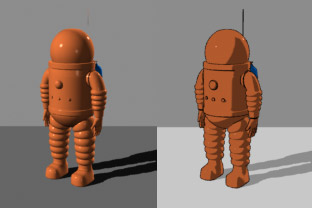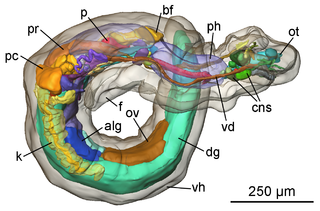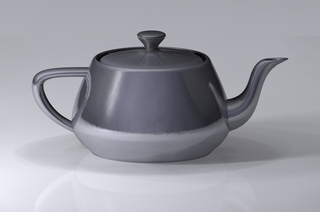Related Research Articles

Rendering is the process of generating a photorealistic or non-photorealistic image from input data such as 3D models. The word "rendering" originally meant the task performed by an artist when depicting a real or imaginary thing. Today, to "render" commonly means to generate an image or video from a precise description using a computer program.
In the field of 3D computer graphics, a subdivision surface is a curved surface represented by the specification of a coarser polygon mesh and produced by a recursive algorithmic method. The curved surface, the underlying inner mesh, can be calculated from the coarse mesh, known as the control cage or outer mesh, as the functional limit of an iterative process of subdividing each polygonal face into smaller faces that better approximate the final underlying curved surface. Less commonly, a simple algorithm is used to add geometry to a mesh by subdividing the faces into smaller ones without changing the overall shape or volume.

Non-photorealistic rendering (NPR) is an area of computer graphics that focuses on enabling a wide variety of expressive styles for digital art, in contrast to traditional computer graphics, which focuses on photorealism. NPR is inspired by other artistic modes such as painting, drawing, technical illustration, and animated cartoons. NPR has appeared in movies and video games in the form of cel-shaded animation as well as in scientific visualization, architectural illustration and experimental animation.

In mathematical analysis, the smoothness of a function is a property measured by the number of continuous derivatives it has over its domain.
In computer graphics and computer vision, image-based modeling and rendering (IBMR) methods rely on a set of two-dimensional images of a scene to generate a three-dimensional model and then render some novel views of this scene.

David Arthur Eppstein is an American computer scientist and mathematician. He is a distinguished professor of computer science at the University of California, Irvine. He is known for his work in computational geometry, graph algorithms, and recreational mathematics. In 2011, he was named an ACM Fellow.

Carlo Heinrich Séquin is a professor of Computer Science at the University of California, Berkeley in the United States.

James F. O'Brien is a computer graphics researcher and professor of computer science and electrical engineering at the University of California, Berkeley. He is also co-founder and chief science officer at Avametric, a company developing software for virtual clothing try on. In 2015, he received an award for Scientific and Technical Achievement from the Academy of Motion Pictures Arts and Sciences.

In computer vision and computer graphics, 3D reconstruction is the process of capturing the shape and appearance of real objects. This process can be accomplished either by active or passive methods. If the model is allowed to change its shape in time, this is referred to as non-rigid or spatio-temporal reconstruction.

Computer graphics is a sub-field of computer science which studies methods for digitally synthesizing and manipulating visual content. Although the term often refers to the study of three-dimensional computer graphics, it also encompasses two-dimensional graphics and image processing.
Ming C. Lin is an American computer scientist and a Barry Mersky and Capital One Endowed Professor at the University of Maryland, College Park, where she is also the former chair of the Department of Computer Science. Prior to moving to Maryland in 2018, Lin was the John R. & Louise S. Parker Distinguished Professor of Computer Science at the University of North Carolina at Chapel Hill.

Jitendra Malik is an Indian-American academic who is the Arthur J. Chick Professor of Electrical Engineering and Computer Sciences at the University of California, Berkeley. He is known for his research in computer vision.
In the mathematical fields of numerical analysis and approximation theory, box splines are piecewise polynomial functions of several variables. Box splines are considered as a multivariate generalization of basis splines (B-splines) and are generally used for multivariate approximation/interpolation. Geometrically, a box spline is the shadow (X-ray) of a hypercube projected down to a lower-dimensional space. Box splines and simplex splines are well studied special cases of polyhedral splines which are defined as shadows of general polytopes.
In computer graphics, free-form deformation (FFD) is a geometric technique used to model simple deformations of rigid objects. It is based on the idea of enclosing an object within a cube or another hull object, and transforming the object within the hull as the hull is deformed. Deformation of the hull is based on the concept of so-called hyper-patches, which are three-dimensional analogs of parametric curves such as Bézier curves, B-splines, or NURBs. The technique was first described by Thomas W. Sederberg and Scott R. Parry in 1986, and is based on an earlier technique by Alan Barr. It was extended by Coquillart to a technique described as extended free-form deformation, which refines the hull object by introducing additional geometry or by using different hull objects such as cylinders and prisms.
You-Dong Liang (梁友栋) is a mathematician and educator, best known for his contributions in geometric modeling and the Liang-Barsky algorithm.

The Kahlert School of Computing is a school within the College of Engineering at the University of Utah in Salt Lake City, Utah.

Eugene Wong is a Chinese-American computer scientist and mathematician. Wong's career has spanned academia, university administration, government and the private sector. Together with Michael Stonebraker and a group of scientists at IBM, Wong is credited with pioneering database research in the 1970s from which software developed by IBM, Microsoft, and Oracle descends. Wong retired in 1994, since then holding the title of Professor Emeritus of Electrical Engineering and Computer Sciences at University of California, Berkeley.
Video matting is a technique for separating the video into two or more layers, usually foreground and background, and generating alpha mattes which determine blending of the layers. The technique is very popular in video editing because it allows to substitute the background, or process the layers individually.
Deepak Kapur is a Distinguished Professor in the Department of Computer Science at the University of New Mexico.
Jiaya Jia is a Chair Professor of the Department of Computer Science and Engineering at The Hong Kong University of Science and Technology (HKUST). He is an IEEE Fellow, the associate editor-in-chief of one of IEEE’s flagship and premier journals- Transactions on Pattern Analysis and Machine Intelligence (TPAMI), as well as on the editorial board of International Journal of Computer Vision (IJCV).
References
- ↑ Bartels, Richard H. Barsky, Brian A. Beatty, John C. (2006). An introduction to splines for use in computer graphics and geometric modeling. Morgan Kaufmann. ISBN 1-55860-400-6. OCLC 695822066.
{{cite book}}: CS1 maint: multiple names: authors list (link) - ↑ Badler, Norman I., editor. Barsky, Brian A., editor. Zeltzer, David, editor. (August 1990). Making them move : mechanics, control, and animation of articulated figures. Morgan Kaufmann. ISBN 978-1-136-11062-7. OCLC 1003855251.
{{cite book}}:|last=has generic name (help)CS1 maint: multiple names: authors list (link) - ↑ Barsky, Brian A. (2013). "Computer Graphics and Geometric Modeling Using Beta-splines". Computer Science Workbench. doi:10.1007/978-3-642-72292-9. ISBN 978-3-642-72294-3. ISSN 1431-1488. S2CID 37345872.
- ↑ Liang, You-Dong; Barsky, B. A. (January 1984). "A New Concept and Method for Line Clipping". ACM Transactions on Graphics. 3 (1): 1–22. doi:10.1145/357332.357333. ISSN 0730-0301. S2CID 18021391.
- ↑ Liang, You-Dong; Barsky, Brian A. (1983-11-01). "An analysis and algorithm for polygon clipping". Communications of the ACM. 26 (11): 868–877. doi: 10.1145/182.358439 . ISSN 0001-0782. S2CID 16653424.
- ↑ Angel, Edward. (2000). Interactive computer graphics : a top-down approach with OpenGL. Addison-Wesley. ISBN 0-201-38597-X. OCLC 658216109.
- ↑ Hearn, Donald. (1997). Computer graphics, C version. Prentice Hall. ISBN 0-13-530924-7. OCLC 868986284.
- ↑ Barsky, Brian A. (2013). "Computer Graphics and Geometric Modeling Using Beta-splines". Computer Science Workbench. doi:10.1007/978-3-642-72292-9. ISBN 978-3-642-72294-3. ISSN 1431-1488. S2CID 37345872.
- ↑ Brian A. Barsky and Tony D. DeRose, Geometric Continuity of Parametric Curves, Technical Report No. UCB/CSD 84/205, Computer Science Division, Electrical Engineering and Computer Sciences Department, University of California, Berkeley, California, USA, October, 1984.
- ↑ DeRose, Tony D.; Barsky, Brian A. (1985), "An Intuitive Approach to Geometric Continuity for Parametric Curves and Surfaces", Computer-Generated Images, Tokyo: Springer Japan, pp. 159–175, doi:10.1007/978-4-431-68033-8_15, ISBN 978-4-431-68035-2
- ↑ Barsky, Brian A., 1954- (1988). Three characterizations of geometric continuity for parametric curves. University of California, Berkeley, Computer Science Division. OCLC 18666153.
{{cite book}}: CS1 maint: multiple names: authors list (link) CS1 maint: numeric names: authors list (link) - ↑ Barsky, Brian A. (2004). "Vision-realistic rendering". Proceedings of the 1st Symposium on Applied perception in graphics and visualization. New York, New York, USA: ACM Press. p. 73. doi:10.1145/1012551.1012564. ISBN 1-58113-914-4. S2CID 7588826.
- ↑ Huang, Fu-Chung; Barsky, Brian A. (2011). "A Framework for Aberration Compensated Displays". Technical Report No. UCB/EECS-2011-162, Computer Science Division, Electrical Engineering and Computer Sciences Department, University of California, Berkeley, California, USA.
- ↑ Huang, Fu-Chung; Wetzstein, Gordon; Barsky, Brian A.; Raskar, Ramesh (2014-07-27). "Eyeglasses-free display". ACM Transactions on Graphics. 33 (4): 1–12. doi:10.1145/2601097.2601122. hdl: 1721.1/92749 . ISSN 0730-0301. S2CID 12347886.
- ↑ "Computer Aided Contact Lens Design and Fabrication Using Spline Surfaces," Inventor: Brian A. Barsky, Patent No. US 6,241,355, June 5, 2001.
- ↑ Weingarten, Marc (12 September 2002). "For an Irregular Lens, an Optical Blueprint". The New York Times.
- ↑ KLEIN, STANLEY A.; BARSKY, BRIAN A. (November 1995). "Method for Generating the Anterior Surface of an Aberration-Free Contact Lens for an Arbitrary Posterior Surface". Optometry and Vision Science. 72 (11): 816–820. doi:10.1097/00006324-199511000-00007. ISSN 1040-5488. PMID 8587770.